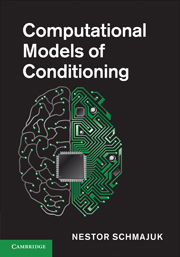Book contents
- Frontmatter
- Contents
- List of contributors
- Introduction
- 1 Evolution of attention in learning
- 2 The arguments of associations
- 3 The hybrid modeling approach to conditioning
- 4 Within-compound associations: models and data
- 5 Associative modulation of US processing: implications for understanding of habituation
- 6 Attention, associations, and configurations in conditioning
- 7 Computer simulation of the cerebellum
- 8 The operant/respondent distinction: a computational neural-network analysis
- Index
- References
7 - Computer simulation of the cerebellum
Published online by Cambridge University Press: 10 January 2011
- Frontmatter
- Contents
- List of contributors
- Introduction
- 1 Evolution of attention in learning
- 2 The arguments of associations
- 3 The hybrid modeling approach to conditioning
- 4 Within-compound associations: models and data
- 5 Associative modulation of US processing: implications for understanding of habituation
- 6 Attention, associations, and configurations in conditioning
- 7 Computer simulation of the cerebellum
- 8 The operant/respondent distinction: a computational neural-network analysis
- Index
- References
Summary
Abstract
The connection between eyelid conditioning and the cerebellum arose from the search for the site of plasticity that mediates eyelid conditioning, but the cerebellum is far more than the site of plasticity for eyelid conditioning and eyelid conditioning is far more than a cerebellum-dependent behavior. The specific relationships between the stimuli used in eyelid conditioning and cerebellar inputs, as well as between cerebellar output and behaviour, make eyelid conditioning a powerful tool for empirical and computational analysis of cerebellar learning and information processing. This relationship makes the well-established behavioral properties of eyelid conditioning a first approximation of the rules for input–output transformations in the cerebellum – that is, for what the cerebellum computes. The practical experimental advantages of eyelid conditioning greatly facilitate analysis of how the neurons and synapses of the cerebellum accomplish this computation. Finally, the close correspondence between eyelid conditioning and the cerebellum provides a rare opportunity to implement biologically relevant and quite stringent tests on the successes and failures of computer simulations of the cerebellum. From these advantages is emerging an increasingly clear and specific story of what the cerebellum computes and how its neurons and synapses produce this computation. One way that this is revealed is in the many ways that current large-scale computer simulations of the cerebellum qualitatively and sometimes quantitatively mimic the many intricate behavioral properties of eyelid conditioning. I will briefly outline previous work laying the foundation for simulation of the cerebellum and identifying the essential basics of learning in the cerebellum. […]
- Type
- Chapter
- Information
- Computational Models of Conditioning , pp. 219 - 243Publisher: Cambridge University PressPrint publication year: 2010



